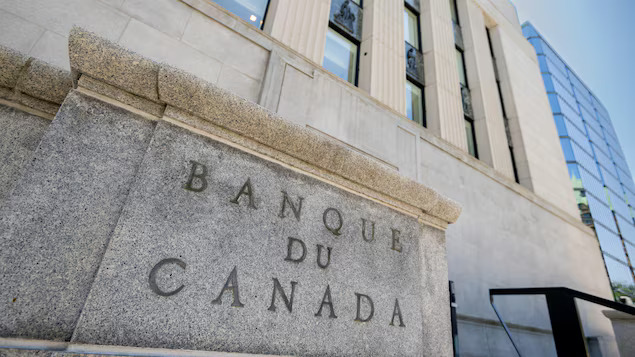Business and Economy
The Bank of Canada’s growing list of worries

The Bank of Canada says progress is being made, but that risks to the forecast remain a concern. PHOTO: RADIO-CANADA / BENOIT ROUSSEL
Rate cuts are coming, but can they help Canada’s economy avoid the many risks ahead?
For months, the Bank of Canada has been trying to thread a needle: slow the economy just enough to get inflation back under control but not so much that it causes a recession.
In a report released this week (new window), the central bank offered up plenty of evidence that its strategy is working. Inflation has eased, economic growth has resumed all while wages are recovering.
But the bank also has a list of things that could quickly derail that progress — from mortgage renewals to population dynamics to conflicts abroad or wildfires in Canada.
Canadian households have been clobbered these past two years by rising prices and increased borrowing costs. It’s easy to look at easing inflation and think better days lie ahead. And most forecasts show the economy should improve over the rest of this year.
But real risks remain — that the bank will be watching for as it decides whether to cut rates again at the July announcement.
Up for renewal
Atop the bank’s list of risks to economic growth is a tsunami of mortgage renewals about to crash into the economy.
The large number of households renewing mortgages at higher rates and with higher payments in 2025 could curb spending and dampen economic activity and inflation more than expected,
wrote the Bank of Canada in its summary of deliberations (new window), which is meant to give Canadians more insight into its monetary policy decisions.
At the same time, the central bank is worried that interest rate cuts could overheat the housing market. Economists have warned that a slowing real estate market has led to pent up demand across the country.

The Bank of Canada worries rate hikes may help over heat the housing market. PHOTO: RADIO-CANADA / DAVID HOREMANS
Population growth
Another key concern is how the economy adjusts to population growth.
New figures released this week show Canada’s population surpassed 41 million people in the first quarter of 2024, less than a year after the population hit 40 million last summer (new window). Almost all the increase was from international migration, according to Statistics Canada (new window).
All those new Canadians add to economic growth. They buy groceries and cars home furnishings.
But even with that boost, GDP growth spent months hovering around zero per cent. If you calculate GDP on a per capita basis, the portrait of the economy is decidedly worse.
The federal government has said it will slow the number of non-permanent residents (new window) it allows to enter the country. That, inevitably, will change one of the driving forces behind what little economic growth Canada has been able to eke out.
The timing and impact of government plans to unwind the rapid growth in non-permanent residents could affect the forecast for inflation and growth,
wrote the bank.
Like everything else in the economy right now, those changes are awash in contradiction.
Strong population growth has added to economic growth. But it has also driven up shelter costs, particularly rents.
More rate cuts to come?
Since it started hiking interest rates in March 2022, the Bank of Canada has warned about the risk of over- or under-tightening. In other words, it worried if it raised rates too high, it would cause unnecessary damage to the economy. But if it didn’t do enough, inflation would continue to surge.
But Benjamin Reitzes, managing director at BMO Economics, says measuring that risk in the midst of the rate-hiking cycle was a nearly impossible task.
You can only know after the fact if you’ve gone too far or too fast. That’s always the case,
he told CBC News. It will be the same the other way … if they ease too fast, they’ll only know after the fact.
WATCH | Bank of Canada governor on rebuilding trust with Canadians:
‘WE’RE GONNA HAVE TO REBUILD THAT TRUST’: BANK OF CANADA GOVERNOR
As interest rates fall for the first time in four years, Tiff Macklem, Bank of Canada governor, sits down with Peter Armstrong, CBC senior business correspondent, to discuss the Canadian economy and accountability.
Reitzes says it generally takes about 18 months for interest rate changes to fully work their way into the economy. But he expects the data over the next few months to align with the forecasts. And if that happens, he says, Canadians can expect more rate cuts in the months ahead.
Markets have priced in three cuts this year. Some think the bank will be more aggressive than that.
Our view remains that the Bank of Canada will ease policy three more times this year, finishing 2024 with a policy rate of four per cent,
wrote Tiago Figueiredo, a macro strategist with Desjardins.
Uncertainty ahead
But these past few years have not been kind to forecasters. Just about every time it looked like experts had a handle on what was happening, the world changed; a new COVID variant, a new war in Europe or the Middle East, another supply-chain shock.
In the wake of all that volatility, even the Bank of Canada seems unsure what to make of certain economic data.
The summary of deliberations points to a recent increase in household savings.
Normally that would be seen as good news. Now, the bank isn’t entirely sure.
Higher savings could be an indication of greater cautiousness among consumers as they wait for economic conditions to improve. It could also reflect reduced spending for those households anticipating higher debt repayments when they renew their mortgage,
wrote the bank.
Peter Armstrong (new window) · CBC News
This article is republished from RCI.





















